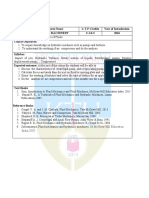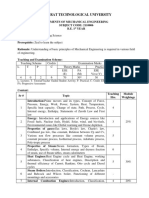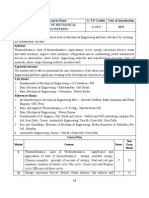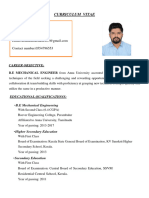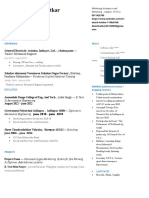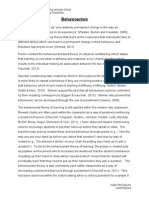Propulsion Engineering S8 Syllabus
Propulsion Engineering S8 Syllabus
Uploaded by
Husni mubsshirCopyright:
Available Formats
Propulsion Engineering S8 Syllabus
Propulsion Engineering S8 Syllabus
Uploaded by
Husni mubsshirOriginal Description:
Original Title
Copyright
Available Formats
Share this document
Did you find this document useful?
Is this content inappropriate?
Copyright:
Available Formats
Propulsion Engineering S8 Syllabus
Propulsion Engineering S8 Syllabus
Uploaded by
Husni mubsshirCopyright:
Available Formats
Course No.
Course Name L-T-P-Credits Year of
Introduction
ME462 Propulsion Engineering 3-0-0 2016
Course Objectives: The main objectives of this course are
1. To provide the students with an overview of various air craft engines
2. To provide students with an overview of various rocket technologies and applications.
3. To provide students with knowledge of the tools to analyze various rocket propulsion.
4. To provide the students with an overview of the testing of rocket engines .
Syllabus:
Fundamentals of Propulsion, Types of propulsive devices, Efficiencies, Thermodynamics
analysis of turbojet, Turbojet engine components, Rocket propulsion, Types of rockets, Flight
Performance, Testing of rockets
Expected Outcomes: At the end of the course students will be able
1. Apply the knowledge in the fields of aircraft and rocket propulsion
2. Perform thermodynamic analysis of aircraft engines
3. Carry out performance analysis of aircraft systems and components
4. Formulate and solve rocket engine problems
Text books:
1. P. Balachandran, Fundamentals of compressible fluid dynamics, PHI Learning,2006
2. S. M. Yahya, Fundamentals of Compressible Flow , New Age International,2008
Reference books:
1. G. P. Sutton and Oscar Biblarz, Rocket Propulsion elements- John Wiley & Sons, 2013
2. Philip Hill, Carl Peterson Mechanics and Thermodynamics of propulsion, Pearson, 2014
Semester
Module Contents Hours Examination
Marks
Fundamentals of Propulsion- Classification types of
propulsive devices-Airscrew, Turbojet, Turboprop,
I turbofan, Turboshaft, Ramjet, Scramjet, Pulsejet and Rocket 7 15%
engines. Comparative study of performance characteristics
applications.
Theory of propulsion – Thrust, thrust power and efficiencies
II of turbojet engine. Thermodynamics analysis of turbojet 7 15%
engine cycle, Propellers: Types of propellers
FIRST INTERNAL EXAMINATION
Turbojet engine components- air intakes, Compressors,
III Combustion chambers, turbines, nozzles turbine and 7 15%
compression matching – Thrust augmentation.
Rocket propulsion- general operating principles of
chemical, electrical nuclear and solar rockets. Chemical
Rockets- Classification. Performance parameters for
IV
chemical rockets and their relationship, Energy and 7 15%
efficiencies, simple problems, Solid propellants- Types-
burning rate- grain Configurations, - Classification- Typical
fuels and oxidizers, properties and specifications, Selection.
SECOND INTERNAL EXAMINATION
Liquid propellant feed systems, injectors, Starting and
ignition, Igniters liquid propellant, Precautions in propellant
V handling. Hybrid Rockets combustion processes in SPR and 7 20%
LPR combustion instability- Control of instabilities –
Cooling of Rocket motors
Flight Performance- Velocity and attitude in simplified
vertical Refractory staging of rockets. Rocket Testing- Test
V1 7 20%
facilities and safeguards. Measurement System
Terminology, Flight Testing.
END SEMESTER EXAMINATION
Question Paper Pattern
Total marks: 100, Time: 3 hrs
The question paper should consist of three parts
Part A
There should be 2 questions each from module I and II
Each question carries 10 marks
Students will have to answer any three questions out of 4 (3X10 marks =30 marks)
Part B
There should be 2 questions each from module III and IV
Each question carries 10 marks
Students will have to answer any three questions out of 4 (3X10 marks =30 marks)
Part C
There should be 3 questions each from module V and VI
Each question carries 10 marks
Students will have to answer any four questions out of 6 (4X10 marks =40 marks)
Note: in all parts each question can have a maximum of four sub questions
You might also like
- Active, Reactive Apparent Power Assignment Student Template Fall 2020Document8 pagesActive, Reactive Apparent Power Assignment Student Template Fall 2020GabrielGreco100% (1)
- SANS 2023 ICS Field Manual Vol3Document16 pagesSANS 2023 ICS Field Manual Vol3George CarvalhoNo ratings yet
- Dialog+ SW9.xx, Service Manual, Chapter 4, TSM Service Program, Edition 2013 (EN) PDFDocument181 pagesDialog+ SW9.xx, Service Manual, Chapter 4, TSM Service Program, Edition 2013 (EN) PDFAlex Landen100% (2)
- Propulsion Engineering S8 Syllabus PDFDocument2 pagesPropulsion Engineering S8 Syllabus PDFHusni mubsshirNo ratings yet
- ME462 Propulsion EngineeringDocument3 pagesME462 Propulsion Engineeringnandan144No ratings yet
- Gujarat Technological University: Fundamentals of Jet Propulsion 6 SemesterDocument3 pagesGujarat Technological University: Fundamentals of Jet Propulsion 6 SemesterAADITYA SHAHNo ratings yet
- Course OutlineDocument2 pagesCourse OutlineAddisu DagneNo ratings yet
- Lecture Reading Books Flight Propulsionfiles 1-Syllabus AE422 FLT Propulsion I SyllabusDocument4 pagesLecture Reading Books Flight Propulsionfiles 1-Syllabus AE422 FLT Propulsion I SyllabusalibariskaplanNo ratings yet
- Aircraft PropulsionDocument2 pagesAircraft Propulsionakashmsd0709No ratings yet
- AerosyllDocument145 pagesAerosyllFarquad Abdul HaqueNo ratings yet
- Course Plan - Turbo MachineryDocument4 pagesCourse Plan - Turbo MachineryAMIT PRAJAPATINo ratings yet
- Gujarat Technological University: W.E.F. AY 2018-19Document3 pagesGujarat Technological University: W.E.F. AY 2018-19gaurav mehtaNo ratings yet
- FTM SyllabusDocument3 pagesFTM SyllabusQwer QwerNo ratings yet
- Wa0094Document3 pagesWa0094VIGNESH RAJNo ratings yet
- Gas Turbine and Jet Propulsion Meng 5715: Course DescriptionDocument5 pagesGas Turbine and Jet Propulsion Meng 5715: Course DescriptionaddisudagneNo ratings yet
- Propulsion Lab and Flight Simulation LabDocument1 pagePropulsion Lab and Flight Simulation LabMokshanandNo ratings yet
- Visvesvaraya Technological University, Belgaum Choice Based Credit System (CBCS) Scheme of Teaching and Examination 2015-2016Document22 pagesVisvesvaraya Technological University, Belgaum Choice Based Credit System (CBCS) Scheme of Teaching and Examination 2015-2016hariNo ratings yet
- Turbo Machinery SyllabusDocument5 pagesTurbo Machinery Syllabustodankarpratham15No ratings yet
- ME604 (ICE>) Lecture NoteDocument125 pagesME604 (ICE>) Lecture NoteKamna Kumar100% (1)
- 18 Me 3-1Document20 pages18 Me 3-1Ashok KumarNo ratings yet
- Institute of Engineering & Technology, Devi Ahilya University, Indore, (M.P.), India. (Scheme Effective From July 2015)Document2 pagesInstitute of Engineering & Technology, Devi Ahilya University, Indore, (M.P.), India. (Scheme Effective From July 2015)Subash AppuNo ratings yet
- Syllabus Propulsion IIDocument1 pageSyllabus Propulsion IIBairaviPerumalVigneswaranNo ratings yet
- ATD SyllabusDocument3 pagesATD Syllabusprashanth prabhuNo ratings yet
- ME461 Aerospace EngineeringDocument2 pagesME461 Aerospace EngineeringloopycrowNo ratings yet
- Mec 4 SyllDocument28 pagesMec 4 SyllTejesh Kumar B MNo ratings yet
- ME 206 Fluid MachineryDocument3 pagesME 206 Fluid MachineryMohammed Asif NNo ratings yet
- AEROSPACE ENGINEERING-II SemDocument19 pagesAEROSPACE ENGINEERING-II SemgovadaveeriahNo ratings yet
- Question Bank: Ae8012 Wind Tunnel TechniquesDocument55 pagesQuestion Bank: Ae8012 Wind Tunnel TechniquesDhanushyaNo ratings yet
- 8th Sem SyllabusDocument16 pages8th Sem SyllabusKalpit Kaurase0% (1)
- 10ME56 Turobo MachinesDocument3 pages10ME56 Turobo MachinesHemanth KumarNo ratings yet
- TMDocument31 pagesTMVINOD NNo ratings yet
- SylableDocument3 pagesSylabledebelaNo ratings yet
- Unit 83 Aircraft Gas Turbine EnginesDocument11 pagesUnit 83 Aircraft Gas Turbine EnginesIisha KalaNo ratings yet
- Me F341 1270Document4 pagesMe F341 1270pankazspamNo ratings yet
- Thermal Engineering IIDocument3 pagesThermal Engineering IIneerubandaNo ratings yet
- ME 206 Fluid Machinery PDFDocument3 pagesME 206 Fluid Machinery PDFnandan144No ratings yet
- Gujarat Technological University: Mechanical Engineering (19) SUBJECT CODE: 2151902Document54 pagesGujarat Technological University: Mechanical Engineering (19) SUBJECT CODE: 2151902Rameshbhai DabhiNo ratings yet
- FRM Course Syllabus IPDownloadDocument2 pagesFRM Course Syllabus IPDownloadMaha RajanNo ratings yet
- Basic Mechanical EngineeringDocument2 pagesBasic Mechanical EngineeringAPOLLO Sem 4 I.T.No ratings yet
- Gujarat Technological UniversityDocument3 pagesGujarat Technological UniversityRavi Teja TNo ratings yet
- ME 230 Fluid Mechanics and Machinery Lab PDFDocument1 pageME 230 Fluid Mechanics and Machinery Lab PDFganeshmd5No ratings yet
- Gujarat Technological University Aeronautical EngineeringDocument2 pagesGujarat Technological University Aeronautical EngineeringHarnil VaghasiyaNo ratings yet
- Gujarat Technological University: W.E.F. AY 2018-19Document3 pagesGujarat Technological University: W.E.F. AY 2018-19Locky ChristinNo ratings yet
- ME 206 Fluid MachineryDocument3 pagesME 206 Fluid MachinerySudeesh SudevanNo ratings yet
- IceDocument3 pagesIceJaniNo ratings yet
- Ic Engine Lab Course OutlineDocument1 pageIc Engine Lab Course OutlinedebelaNo ratings yet
- ME321 Turbomachines 2020Document4 pagesME321 Turbomachines 2020Ashish DaundkarNo ratings yet
- 4th YR SEM-I SyllabusDocument9 pages4th YR SEM-I SyllabusVenkateswara Rao ChellaboinaNo ratings yet
- ME605 - Internal Combustion Engineering PDFDocument3 pagesME605 - Internal Combustion Engineering PDFRajkumar SinghNo ratings yet
- KTU BASICS OF MECHANICAL ENGINEERING SyllabusDocument2 pagesKTU BASICS OF MECHANICAL ENGINEERING SyllabusJerin CyriacNo ratings yet
- Theory of MachinesDocument14 pagesTheory of MachinesGourav KotriwarNo ratings yet
- Gujarat Technological University: Bachelor of Engineering Subjectcode: 3142201Document3 pagesGujarat Technological University: Bachelor of Engineering Subjectcode: 3142201simant kumar sinhaNo ratings yet
- Aerospace PropulsionDocument2 pagesAerospace PropulsionMurugan NNo ratings yet
- Gujarat Technological University: Semester - I/II Subject Name: Basic Mechanical EngineeringDocument3 pagesGujarat Technological University: Semester - I/II Subject Name: Basic Mechanical EngineeringNirmal KushwahaNo ratings yet
- Final Revised ME342 TurbomachinesDocument4 pagesFinal Revised ME342 TurbomachinesNikhil SatbhaiNo ratings yet
- 4th Sem NEP SyllabusDocument11 pages4th Sem NEP SyllabusVikram C KNo ratings yet
- Chhattisgarh Swami Vivekanand TechnicalDocument8 pagesChhattisgarh Swami Vivekanand TechnicalLakshminarayana ChNo ratings yet
- I. Understand The Applications of Engineering Thermodynamics in Real Life SituationsDocument18 pagesI. Understand The Applications of Engineering Thermodynamics in Real Life SituationstbnjhjlkkkkkkNo ratings yet
- B. Tech. 8 Semester Mechanical Engineering: Theory Sessional TotalDocument10 pagesB. Tech. 8 Semester Mechanical Engineering: Theory Sessional TotalAbhishek MeNo ratings yet
- Hydraulics and Pneumatics SyllabusDocument2 pagesHydraulics and Pneumatics SyllabusMulu Girmay67% (3)
- The Traveling Engineers' Association to Improve the Locomotive Engine Service of American Railroads Examination Questions and Answers for Firemen for Promotion and New Men for EmploymentFrom EverandThe Traveling Engineers' Association to Improve the Locomotive Engine Service of American Railroads Examination Questions and Answers for Firemen for Promotion and New Men for EmploymentNo ratings yet
- Administracion de Operaciones - CompletoDocument246 pagesAdministracion de Operaciones - CompletojhlaravNo ratings yet
- Rigi File ZWiMaVVOvd BeebyVP2Document5 pagesRigi File ZWiMaVVOvd BeebyVP2krishnasarika143No ratings yet
- Fast Facts 2002Document118 pagesFast Facts 2002Michael KashiotisNo ratings yet
- Java Worksheet1Document2 pagesJava Worksheet1AbdulwahidNo ratings yet
- Resume Abhilash SDocument10 pagesResume Abhilash SmostafaNo ratings yet
- Akash Shankar Hatkar: Trainee Mechanical EngineerDocument1 pageAkash Shankar Hatkar: Trainee Mechanical EngineerAkash shankar HatkarNo ratings yet
- RV-RVR: Assembly and Main Instructions For Use and MaintenanceDocument52 pagesRV-RVR: Assembly and Main Instructions For Use and MaintenanceJose Maria Franquet SalvoNo ratings yet
- Suntech 325 PolyDocument2 pagesSuntech 325 PolyRizky Tri UtomoNo ratings yet
- 2.2 Determinants of Demand ExerciseDocument4 pages2.2 Determinants of Demand Exercise贾子渲No ratings yet
- William P. Walters - Explosive Loading of Metals and Related TopicsDocument134 pagesWilliam P. Walters - Explosive Loading of Metals and Related TopicsGhoree23456No ratings yet
- Dissertation Customer JourneyDocument8 pagesDissertation Customer JourneyHelpWithPapersCanada100% (1)
- Class 10 English Question Paper Set 1 (2 - 1 - 1) 2022 With Solutions PDFDocument12 pagesClass 10 English Question Paper Set 1 (2 - 1 - 1) 2022 With Solutions PDFrahulv5409323No ratings yet
- Geotechnical Risk Management For Open Pit Mine Closure: A Sub-Arctic and Semi-Arid Case StudyDocument24 pagesGeotechnical Risk Management For Open Pit Mine Closure: A Sub-Arctic and Semi-Arid Case StudydiegoNo ratings yet
- Detailed Lesson Plan Template (Factors Affecting Climate. Altitude)Document8 pagesDetailed Lesson Plan Template (Factors Affecting Climate. Altitude)Lyndon MorescaNo ratings yet
- Nexgenie Base Unit InstallationManualDocument2 pagesNexgenie Base Unit InstallationManualSteps Knowledge Services Pvt Ltd.No ratings yet
- MSRA-ITP - Demolition & Strengthening WorksDocument41 pagesMSRA-ITP - Demolition & Strengthening WorksAfsar AliNo ratings yet
- Electric Circuit Analysis Part111 PDFDocument244 pagesElectric Circuit Analysis Part111 PDF1B Telkom - Galant Muhammad PashaNo ratings yet
- Lecture Notes: Manila Cavite Laguna Cebu Cagayan de Oro DavaoDocument5 pagesLecture Notes: Manila Cavite Laguna Cebu Cagayan de Oro Davaoace ender zeroNo ratings yet
- Why Aircraft Body Is Made of Aluminum and Why Refrigeration Is Done Inside AircraftDocument4 pagesWhy Aircraft Body Is Made of Aluminum and Why Refrigeration Is Done Inside AircraftPrem KumarNo ratings yet
- Pathways: This Place Long IslandDocument10 pagesPathways: This Place Long IslandMaryLynne MaloneNo ratings yet
- Squares and Square RootsDocument28 pagesSquares and Square RootsNagendra DevathaNo ratings yet
- Learning Theories AssignmentDocument5 pagesLearning Theories Assignmentapi-292078202No ratings yet
- Is 8147 1976Document173 pagesIs 8147 1976agrawalniteshNo ratings yet
- Resume Mitesh Suneriya W CTCDocument3 pagesResume Mitesh Suneriya W CTCMiteshSuneriyaNo ratings yet
- Selected Course Outline - 8Document1 pageSelected Course Outline - 8DawitHailuNo ratings yet
- Writing Inverse Routine With Expert RoutineDocument13 pagesWriting Inverse Routine With Expert RoutineAnil KumarNo ratings yet
- AAC-018 The Problem of Bogus PartsDocument7 pagesAAC-018 The Problem of Bogus PartsIsrael UgaldeNo ratings yet

























